Does your family love to learn on the go? Do you have a child who’s interested in Native American history or culture? Are you studying about Native Americans as part of your homeschool in the coming years? If so, we would love to have your family join us on our next road trip to New Mexico–the Land of Enchantment!
Native Americans and their history and culture are fascinating subjects, and they are topics that our children should learn and understand more about. For that reason, we are so excited to announce this Homeschool Enrichment Adventure Road Trip (We call them HEART trips.) ♥ to New Mexico on October 13-17, 2019!

What Is a HEART Trip?
If you’re not familiar with our HEART trips, they are simply educational road trips. We think of them as extended educational field trips for the whole family! It’s hard to believe that we started these road trips four years ago, and this will be our sixth trip. We’re enjoying meeting and traveling with so many homeschooling families, including several families who’ve joined us on every one of our trips so far! We love accompanying you on these educational family road trips, getting to know you, and sharing in some exciting educational experiences together.
We always have fun educational activities, and we always build in some time for families to get to know each other and make connections with other like-minded families. We all know that our kids (contrary to popular belief) typically spend plenty of time socializing, but we parents are the ones who don’t often have time to create true friendships! On these trips, we make time for educational activities and do plenty of learning, but we also make time for building life-long friendships with other homeschooling families–moms and dads included! Note: It is not required that both parents attend these trips, but we do encourage dads to attend when they can!
Community
Most nights after dinner (even when we are not enjoying dinner as a group), we will have a group gathering. One night we will have game night, so be sure to bring your favorite games, and we will have a table set up for it! One night will be pizza and painting (there will be alternatives if pizza is a no go in your house). We know this community aspect is what makes our trips different. We will always put an emphasis on bringing families together and making memories!
For more information about what we’ll be doing on our trip, keep reading!
Research shows when you engage your senses, you are able to retain the information better… so we plan to not only engage every one of your senses on this trip but to delight them! From feasting your eyes on the most beautiful New Mexico vistas to creating your own beauty with a painting of our experience. Or how about the sounds of calming water as we raft a gentle Rio Grande? But we don’t stop there… your taste buds and olfactory senses will be transformed after you experience green chile… because they say you haven’t had chile until you’ve had New Mexico’s green chile (not to mention the most amazing savory breakfast burritos we’ve ever tasted)! Finally, we will not only gaze upon and appreciate these gorgeous vistas from afar, we will actually hike to some and get up close and personal with them! This trip will immerse you and your children in the Native American world, and we expect it will be an educational experience you won’t forget!!
Los Rios River Runners
NATIVE CULTURES FEAST & FLOAT
We are so very excited to be going on a Native Cultures Feast & Float on the beautiful Rio Grande! The Rio Grande valley has been home for over a thousand years to many Pueblo Indian tribes who still follow their traditional ways. On calm waters, we will jump right into an immersive study as we learn about their culture from our interpretive guide who will share about Pueblo history and tradition.
After our float, we will enjoy a delicious traditional feast meal! This meal will be prepared and served by a Pueblo Indian family and will include red chile stew, blue corn posole (a thick, hearty soup), calabacitas (a delicious side dish made of vegetables), fry bread, Indian pie, and Indian tea.
To get more details on our float, click this link and watch the video below. This gentleman and his family, along with many skilled rafters, will be our guides on this gentle float down the Rio Grande.
Taos Pueblo
Over 1,000 years of Tradition
Taos Pueblo is a sovereign Pueblo Indian community located in Taos County in northern New Mexico where we will see multi-storied adobe buildings that are estimated to be over 1,000 years old! The Red Willow People have continuously inhabited Taos Pueblo for over 1000 years, and it is the only living community to be listed in the Registry of National Historic Landmarks and recognized by the United Nations Education, Scientific and Cultural Organization (UNESCO) as a World Heritage Site.
When the Spanish came to Pueblo country, some assumed they had found their “Cities of Gold” because the micca used to mud the buildings glitters like gold. The homes there are still used for religious and cultural activities.
The shops in Taos Pueblo have operated for three generations and are still in business. Each one carries a variety of handcrafted arts and crafts. The shopkeepers will be happy to tell you how and where your purchase was created!
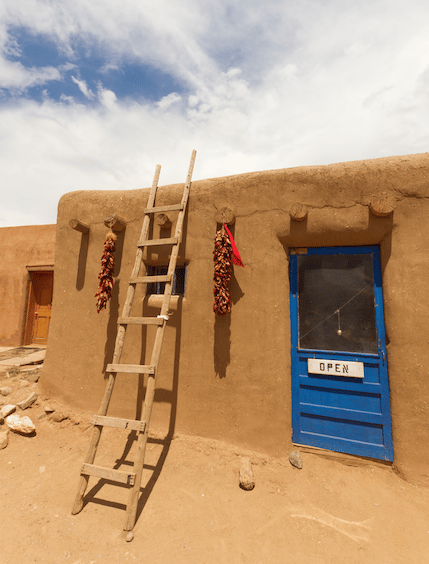
Artisans of the community
Unlike other communities, many artisans here interact directly with visitors. Their shops, which are owned and operated by the artist and family members, feature pottery, paintings, sculptures, and more.
Rio Grande Gorge
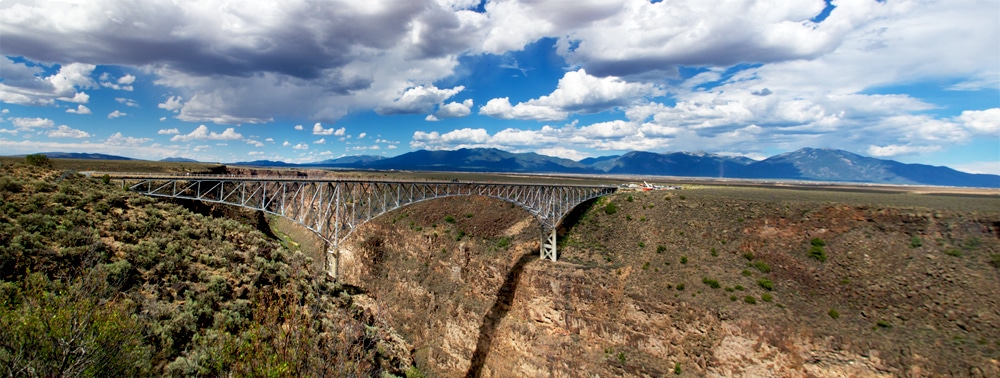
We will experience the beautiful Rio Grande Gorge and this magnificent bridge–the second highest bridge on the U.S. Highway System and the fifth highest bridge in the United States. The bridge is a three-span steel continuous-deck-truss structure with a concrete-filled steel-grid deck. It was called the “bridge to nowhere” while it was being built because the funding did not exist to continue the road on the other side. It is a1280 foot cantilever bridge and it provides a major east-west highway in north-central New Mexico.
When we leave Taos we enter a broad and flat plain. This desert area has very little vegetation and spreads out for miles. If it wasn’t for the vision of that amazing bridge ahead, you wouldn’t have any idea that the ground opens up into a huge chasm. Here, the gorge is about 800 feet deep and is where you will find the Rio Grande River.
It has even been named “Most Beautiful Steel Bridge” in the “Long Span” category. The bridge has appeared in several films, including Paul, Terminator Salvation, Natural Born Killers, Wild Hogs, and White Sands.
Earthships

We are excited to visit and learn about Earthships while we are in New Mexico! An Earthship is a brand of passive solar earth shelter that is made of both natural and upcycled materials such as tires. The Earthship was pioneered by architect Michael Reynolds. The Earthships address six principles or human needs:
- thermo-solar heating and cooling
- solar and wind electricity
- self-contained sewage treatment
- building with natural and recycled materials
- water harvesting and long term storage
- some internal food production capability
Earthship structures are intended to be “off-the-grid-ready” homes. In other words, they have little dependence on public utilities or fossil fuels and instead rely primarily on natural resources–especially the sun and rain water. They are constructed to use available natural resources.
Architect Mike Reynolds is quite the character. The 2007 film, Garbage Warrior, is about him. It tells the story of how he developed this idea and style of buildings and then how he struggled with the laws of Taos for permission to build these homes that don’t fit into local building codes. These building are not just functional they are beautiful and inspiring!
San Francisco De Asis
 We will visit the San Francisco de Asis Mission Church. It is a late example of Spanish Colonial architecture and is a perfect case study in modern preservation practices. This mission was made iconic in paintings and photographs by artists such as Georgia O’Keefe and Ansel Adams. The Mission is now fixed in the popular imagination as an archetypical image of New Mexico. It is significant because of its history and architecture and was built between 1772 and 1816. It is listed as a National Historic Landmark.
We will visit the San Francisco de Asis Mission Church. It is a late example of Spanish Colonial architecture and is a perfect case study in modern preservation practices. This mission was made iconic in paintings and photographs by artists such as Georgia O’Keefe and Ansel Adams. The Mission is now fixed in the popular imagination as an archetypical image of New Mexico. It is significant because of its history and architecture and was built between 1772 and 1816. It is listed as a National Historic Landmark.
Chimayo
Chimayó is a community that was founded near the end of the 17th century by Spanish settlers in a fertile valley nourished by the Santa Cruz River.
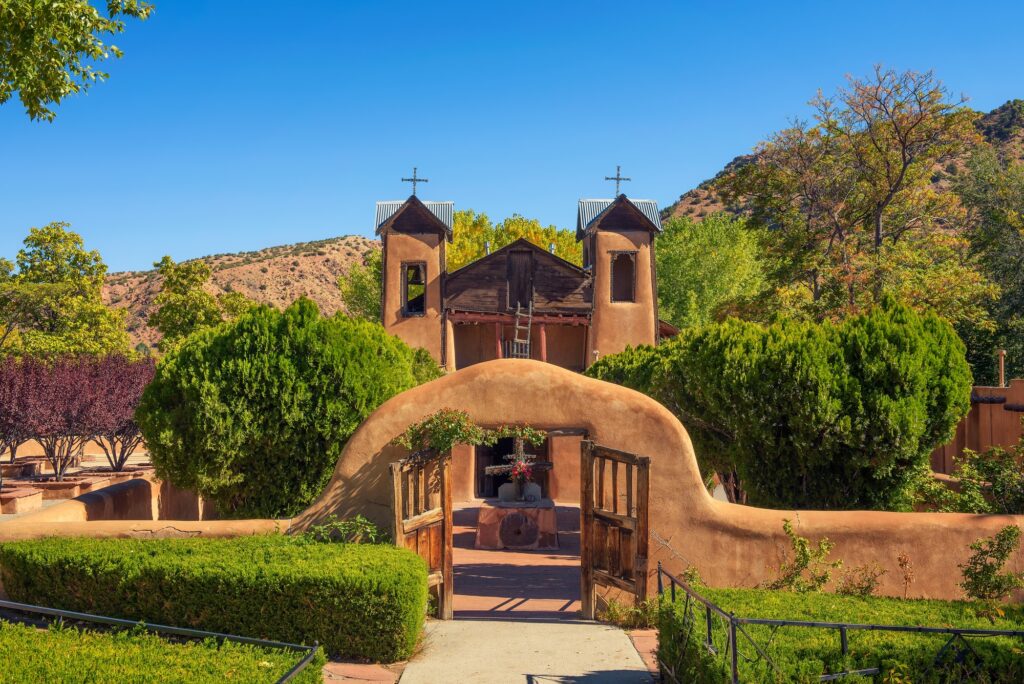
The settlers who founded it became experts at farming, stock raising, and wool weaving. They also built the last surviving fortified plaza, the plaza of San Buenaventura (now the Plaza del Cerro) to protect themselves from threats.
The descendants of the original settlers are still known for their high-quality weaving, red chile, horse and sheep raising, and fruit orchards. The area is also famous for traditional Hispanic and Tewa Indian arts including wood carving, paintings of saints on retablos (flat wood slabs) and bultos (sculptures), tin working, colcha embriodery, and pottery.
A Miracle…
Chimayó is also believed by many to be the site of a miracle which occurred about 200 years ago. Because of that miracle, a chapel, el Santuario de Nuestro Señor de Esquipulas, was built there. This chapel, now commonly called el Santuario de Chimayó, is the destination of thousands of pilgrims and travelers each year.
Many believers in the Santo Niño de Atocha also come to Chimayó. In the beginning of World War II many New Mexico soldiers were stationed in the Phillipines because of their fluency in Spanish.
During the long siege of Corregidor and the subsequent Bataan Death March many of our soldiers prayed to the Santo Niño de Atocha and many believed that they survived as a result of his intercession. After the war these soldiers began the annual Easter tradition of walking to el Santuario de Chimayó in honor of the Santo Niño de Atocha and in memory of the Bataan Death March. The tradition flourished, and in the days leading up to Easter the roads and paths in north-central New Mexico are filled with people young and old making the journey on foot.
For many, Chimayó is the starting point and most important stop on the High Road to Taos, the breathtaking trip that begins at the Rio Grande river and winds through high alpine forests of dark ponderosa pine and golden aspen and tiny, ancient adobe communities nestled in the Sangre de Cristo mountains. The journey ends in the skiing and art community of Taos.
Puye Cliff Dwellings
We will drive seven miles over rolling hills that flatten out as we continue to climb until we reach the towering Puye Cliff Dwellings. There, we will enjoy a tour of the ruins and will see a view very similar to the one that visitors saw in the early part of the 20th century. Two buildings are at the base of the mesa, and both were built with blocks made from shaped volcanic tuff which was found at the site. This spectacular mesa-top pueblo is the largest ancestral native settlement on the Pajarito Plateau, and it once supported 1,500 people.
From the late 1100s until 1580, Puye Cliffs was home to 1,500 Pueblo Indians. In the late 1500s, the inhabitants moved into the Rio Grande River valley–probably because of drought. Today’s Santa Clara people are descendants of the Puye Cliffs people.
The Puye Cliffs consist of two levels of cliff dwellings cut into the cliff face and dwellings on the mesa top. The first level if over a mile long and runs the entire length of the base of the mesa. The second level is about 2,100 feet long. Stairways and paths were cut into the face of the rock to connect the two levels and to allow people to climb to the top of the mesa.
We will learn much more about these dwellings and their history during our visit. We will see some reconstructions and visit the Fred Harvey House–which is used as the visitor center.
Jemez National Historic Landmark
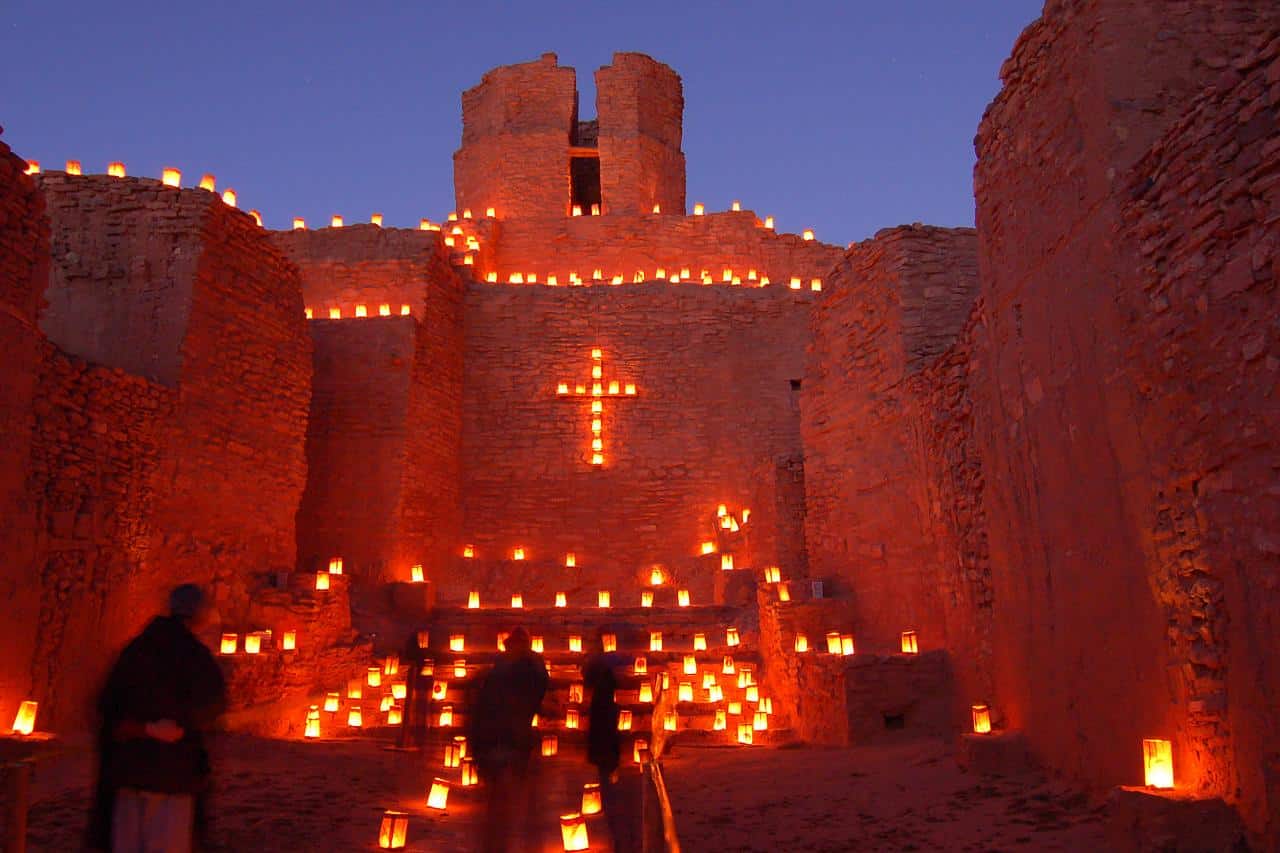
The Jemez National Historic Landmark is one of the most beautiful prehistoric and historic sites in the Southwest. It includes the stone ruins of a 500 year old Indian village and the San José de los Jemez church dating to 1621/2. The village of Giusewa was built in the narrow San Diego Canyon by the ancestors of the present-day people of Jemez (Walatowa) Pueblo. The name Giusewa refers to the natural springs in the area.
The history of the area and the people is rich and interesting, and we’ll have the opportunity to learn more about it during our trip!
Bandelier National Park
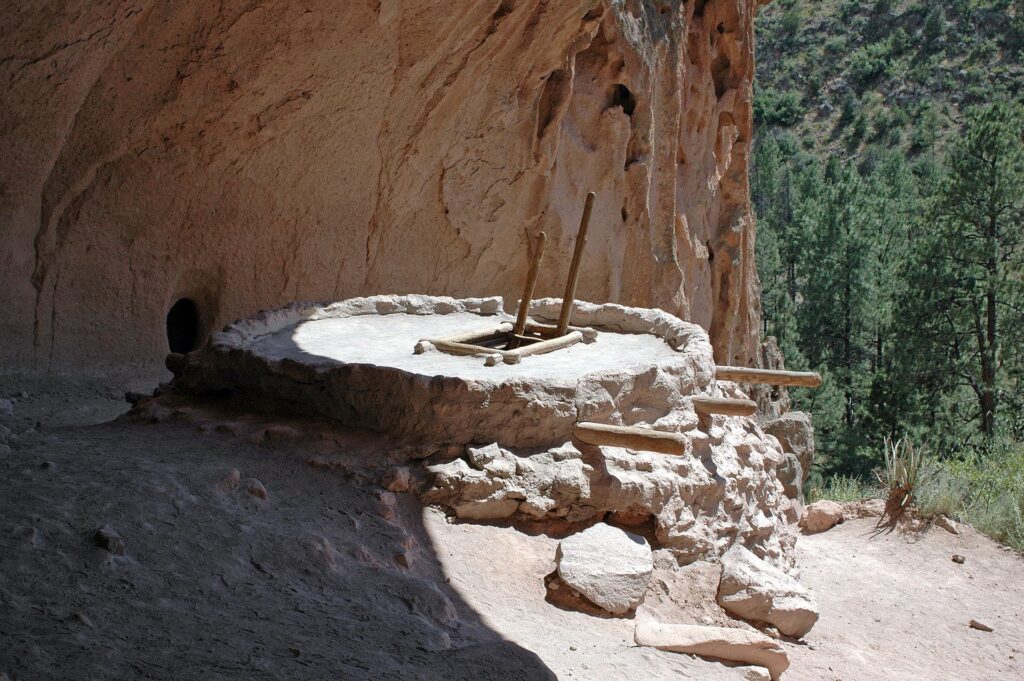
Bandelier’s human history extends back to a time when hunger-gatherers followed migrating wildlife across the mesas and canyons. Later, the Ancestral Pueblo people built more permanent settlements and then eventually moved to pueblos along the Rio Grande.
In the mid-1700s, Spanish settlers lived in the Frijoles Canyon. Jose Montoya of Cochiti Pueblo brought Adolph F. A. Bandelier to Frijoles Canyon to show Bandelier his people’s ancestral homelands. In 1916, legislation to create Bandelier National Monument was signed by President Woodrow Wilson. For several years during World War II, the park was closed to the public and the Bandelier lodge was used to house Manhattan Project scientists and military personnel.
Tent Rocks National Park

At Tent Rocks, we will have the opportunity to observe, study, and experience the geologic processes that shape natural landscapes. The cone-shaped tent rock formations are the products of the volcanic eruptions at Valles Caldera that left pumice, ash, and tuff deposits (tuff is a light, porous rock formed by consolidation of volcanic ash) that are over 1,000 feet thick.
Tent Rocks is like a mini version of Arizona’s Antelope Wells crossed with Turkey’s Cappadocia. Eighty to ninety Tent Tocks were created by the erosion of the soft, air-laden volcanic stone underneath that leaves harder stone intact on top (cap rock).
Indian Pueblo Cultural Center
The Indian Pueblo Cultural Center boasts a schedule of rotating exhibits in their South Gallery, but their main attraction is their permanent exhibit, “We Are of This Place: The Pueblo Story.” This exhibit shares the Pueblo people’s legacy using their own words and voices. Even the design of the exhibit is inspired by traditions that have been passed down for generations.
At the Indian Pueblo Cultural Center, we will enjoy a “pre contact” dishes from the Pueblo people’s past and gain insight into the wealth of flavors found in indigenous diets before Europeans colonized the Americas. It may be a surprise to some of us that beef, chicken, wheat, butter, refined sugar, and common rice won’t be among the foods we will try since these weren’t a part of the Pueblo people’s past until they were later introduced in North America. This experience will open a cultural and educational dialogue about the origins of the foods that Americans do or do not consume on a regular basis and why.
(To register, keep scrolling until you see the “Ready to Register?” section below.)
When: October 13 – 17, 2019 (5 days / 4 nights)
Where: Northern New Mexico
Payments: Please see the information below for pricing and payment information. Each family will need to pay a registration fee of $250 at time of registration and will need to pay 1/4 of your balance each month (June, July, August, and September). Later registrations will require larger payments each month in order to pay the total amount by the due date.
The cost for this trip has several components:
- Registration fee of $250 per family
- Activity fee per person (ages 5 and up)
- Accommodations (by family)
- Add-on activities (per person)
- Add-on meals (per person–available at a later date)
To get your exact price, scroll to the bottom and complete the registration form (you don’t have to submit it)!
Registration Fee: Because we try very hard to charge reasonable prices for activities, meals, and hotels, we have had to start charging a registration fee. This $250 fee is the amount we charge per family to ensure that your family is signed up to attend the trip with us and to cover the services listed below. Because we have a limited number of available “spaces” for families to attend, paying the registration fee ensures that your family has secured one of those spaces. And because we work so hard to plan our trips and all the necessary details, this registration fee helps cover a small part of the time we contribute to researching, planning, phone calls, paperwork, and so on. For more information about what this fee covers, please see the list below.
- searching for and securing accommodations for families who travel with us (including paying deposits to secure blocks of rooms at hotels, RV parks, campgrounds, etc.)
- researching and choosing destinations to include in our trip
- working with destinations to plan activities, tours, and so on
- paying guides who will accompany us on our travels to teach, answer questions, and make our trip enjoyable and educational
- researching and planning for meals that are included in our activities
- researching and planning for meals to offer as add-ons for those meals that aren’t included in our activities
- traveling (several months ahead of time) to the hotels, RV parks, campgrounds, and destinations to take a closer look at accommodations and destinations we’ll be using during our trip
Accommodations
This will be our first trip where we don’t stay in the same place for the entire trip. Because everything in New Mexico takes so much time to get to, we decided we would rather move than spend so much time commuting back and forth for hours. On this trip, you will have the option of staying in your own RV or of staying in the hotel. Prices for RV campers and for the available types of hotel rooms are found below on the registration form. Here you can see the types of rooms along with the beds in each type of room.
- Sagebrush Inn – Junior Suite – 1 queen bed and 1 queen wall bed
Meals
Many of our meals are included in the Activity Fee. Included meals are listed below. Please see the information below the listed meals for more information about each meal and what’s special about it!
- breakfast all 4 mornings (Monday through Thursday) for those staying in the hotel*
- Native American Cultural Immersion Feast (dinner on the first night)
- Pizza from Dion’s (dinner on the third night)
- Indian Pueblo Cultural Center-Pueblo Harvest (lunch on the last day)
Native American Cultural Immersion Feast: After floating on the Rio Grande for about an hour and a half, we will disembark to find a delicious traditional feast waiting for us! This meal will be prepared and served by a Pueblo Indian family and will include red chile stew, blue corn posole, calabacitas, oven bread or fry bread, Indian pie, and Indian tea.
Pizza from Dion’s: This Albuquerque-based chain offers sandwiches, pizzas, and salads. Pizza dough is made fresh at the store, and breads, brownies, cookies, and salad dressings are made at the Dion’s “commissary” in Albuquerque, supplying all locations with the same high-quality goods. They offer specialty menus for food allergies including gluten free options. (Yay!!)
Indian Pueblo Cultural Center-Pueblo Harvest: Located inside the Indian Pueblo Cultural Center, Pueblo Harvest is a full service restaurant known for extraordinary regional and Native-sourced, Pueblo-inspired cuisine that blends honoring legacy and history with exhibiting artistry and modernity. Here we will enjoy a rich flavor palette from the past and gain meaningful insight into the wealth of flavors found in indigenous diets before Europeans colonized the Americas. These dishes will open for us a cultural and educational dialogue about the origins of the foods that Americans do or do not consumer on a regular basis and why.
Payments, Cancellations, and Refund Policies
Your non-refundable registration fee of $250 is due upon registration. We cannot make any changes nor can we offer any refunds after July 1st. Note, we will need at least 10 families to register to be able to confirm this trip. You will be able to pay your registration fee once the registration form has been added to this article. If you are on our email list, you’ll receive an email once registration opens. We will also post on our Hip Homeschool Moms Facebook page and our Homeschool Road Trips Facebook page. Also, be sure to come back and look at this article again since you’re not guaranteed to see our posts on Facebook.
Add-on Events:
Balloon Flight
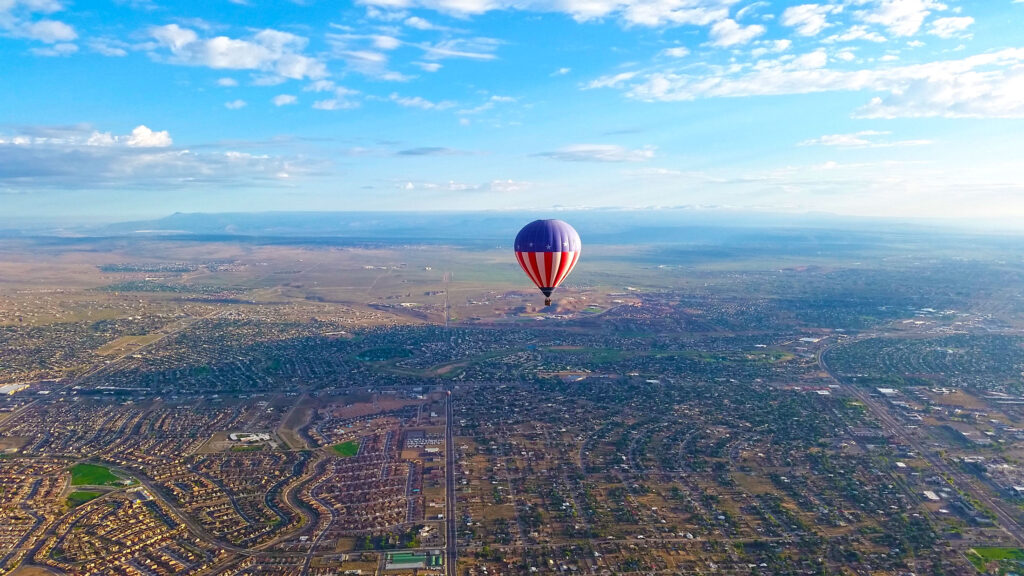
Cost for this add-on: $150 + tax per person. Restrictions apply. Please see “important information” below.
We are thrilled to offer an add-on hot air balloon flight for those who want to participate. (And we highly suggest that you do!) We took hot air balloon flights ourselves before we decided for certain whether to offer this add-on. After our flights, we knew we had to include this option!
Albuquerque balloon adventures all begin at sunrise. We will gather at the launch site to help get these beautiful balloons aloft! We will learn about how and why they work. We will watch the balloons as they are inflated (which is so cool to watch!!). Then we’ll lift off for a peaceful journey over the Rio Grande Valley. Balloons can carry up to 12 passengers, and our flights will last about an hour.
After our flights, the World Balloon crew will greet us and help us celebrate our voyages with the traditional champagne (or sparkling cider) toast, a light continental breakfast, and commemorative flight certificate suitable for framing. And of course you’ll also have memories to last a lifetime!
Albequerque has the distinction of being “The Balloon Capital of the World” because of the beautiful flying conditions, being home to over 300 balloon pilots, and hosting the largest balloon event anywhere. (The Albuquerque International Balloon Festival is held for 9 days each year in October.) In fact, the founder of World Balloon, Sid Cutter, was also the founder of the Fiesta, so it’s no surprise that World Balloon has been, and continues to be Albuquerque’s highest rated balloon operator since 1973.
IMPORTANT INFORMATION ABOUT BALLOON FLIGHTS:
Please understand that, if weather conditions do not permit, our hot air balloon flights won’t be possible.
There are some restrictions on passengers for the hot air balloon flights. These are strictly enforced.
- All passengers must be 6 years of age or older. Age 6-18 requires parent or guardian to fly.
- Maximum weight per passenger cannot exceed 280 lbs. Passengers may be asked to be weighed for accuracy at check-in.
Passengers with the following conditions cannot fly:
- Expectant Mothers.
- Back, Neck, Knee, Hip, Joint, Bone, Osteoporosis or Similar Physical issues within 2 years.
- Inability to walk unassisted or stand for one hour unassisted. Canes / Walkers / Wheel chairs / Scooters not permitted.
- Recent Surgeries or Other Conditions that may be aggravated during flight and landing.
Accessibility and service animals:
Unfortunately none of the aircraft are considered handicapped accessible. They are unable to accommodate wheel chairs and do not have doors to allow for access other than climbing over the sidewall of the basket. There is also no way for the aircraft to be modified to be made handicapped accessible. Additionally, they love animals and want them to be safe and protected. This unfortunately means that they do not allow service animals onboard or around the aircraft. Hot Air Balloon burners are loud and will scare many animals. It is simply not safe or prudent to allow a service animal in or around the aircraft.
Ready to Register?
Once you have registered and paid your registration fee, you will be added to a private Facebook group that is only for those adults who will travel to New Mexico with us. (We do this for each of our HEART trips.) This allows those who will be attending to start getting to know each other. It also give us a place to share important information with those who will attend. We’ve seen many life-long friendships begin on our trips, and we expect the same thing to happen in New Mexico! That is one of the greatest missions of these HEART trips–building community for families living the home education lifestyle. We can’t wait to meet you!! ♥ ♥ ♥
IMPORTANT NOTE ABOUT YOUR REGISTRATION FORM:
- Once you’ve filled out the form below, this page will reload. PLEASE be sure to scroll back down to the bottom of the page to be sure your form was correctly filled out and accepted. If any information was missing, you’ll see that space highlighted in red and will need to add the information and submit the form again.
- Once you’ve submitted the form and it has been accepted, you will see a message (when you scroll back down to the bottom of the page again) that says “Your information was submitted. Thanks for registering. Be on the lookout for an email.”
- Your next step will be to check your email to be sure you received the confirmation email. The confirmation email will have the information you submitted along with your total amount due.
- In a day or two, you will receive a PayPal invoice so you can pay your $250 registration fee. (We have to send these out ourselves since they are not automatically generated.) Please pay this invoice right away in order to secure you spot on our trip.
- Once your registration fee is paid, Trish and Wendy will send you Facebook friend requests and will add you to our private Facebook group (just for our New Mexico HEART Trip attendees). This private group is where we make plans, share important information, and get to know each other, so it is very important that you (or at least one adult who is attending the trip and who is doing the planning for your family) join this group! Otherwise, you will miss important information.
If you have any questions, please email us, and we will be glad to help!! Be sure to put “New Mexico Questions” in your subject line.
We look forward to seeing you in New Mexico!

![]()


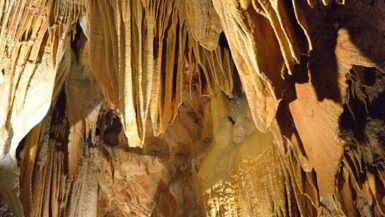
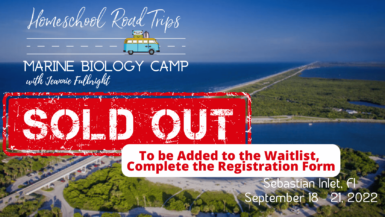

What a wonderful opportunity! This would be an amazing experience for our family, as we have never explored the western part of the United States. My husband, 14 year-old son, 9 year-old daughter and I would enjoy learning about this area first-hand, as we’ve only read about it in books. Our son, Clayton, has a special affinity for Native American history, and would certainly appreciate learning about the Navajo way of life. It would surely be a life-changing event, meeting up with other home schoolers from across the nation to partake in this journey…
This trip looks fantastic!
This would be an amazing trip to win. I have one child, a boy16 yrs old. He would love to go on this trip but we cant afford it. So here’s hoping to win. Thanks for the chance.
This looks like an amazing trip!! We will be saving and praying that we get the chance to join you all!!
So very excited! This is my birthday weekend!!! I hope we win!!
Sounds wonderful!! I’m sure everyone will have a great time with these two ladies at the helm.
What an exciting way to learn! Love creating family memories while learning.
My husband, myself, and our 2 children with special needs will attend! Our daughter is 14 and our son is 12. This is a trip of a lifetime!
This looks super interesting! My boys would really enjoy it as this is not something they’ve learned much about yet.
We loved our trip last year to Space Camp with Hip Homeschool Moms. I really hope we can make the November trip! It looks like so much fun. We have entered the give away and have our fingers crossed. Thank you!
Why would you like to win this Homeschool Enrichment Adventure Road Trip? If you do win, who will attend the trip?
We are a family that would love to provide our children with opportunities that at this time we really cannot afford. Winning this trip would be a blessing without an extreme financial burden.
I would attend the trip with my three sons.
Thanks for the opportunity to win this trip!
This sounds like an amazing experience! You ladies are awesome.
This sounds so fun! If we won, it would be me, hubby, and two daughters (17 & 15) attending. Thank you so much for the chance to win this amazing trip!
an opportunity to win this contest would really bless my family! We have been separated for over a year as my husband is working in Tennessee and I’m trying to sell a house in California. We have a 15 year old son and this would be a perfect opportunity for him to explore the historical side with the cultural side of today’s Native American Indian
We’d love to explore New Mexico! It’s only one state over from us, but we’ve never road tripped that direction!
This would be so awesome but we are a family of 8.
I want to win this trip because it seems so fun. I have never done anything like it. I would bring my husband and 14 year old daughter, if my husband could get off work. Maybe another family member too.
Oh my gosh! This would be amazing! I’ve been looking for Native American studies we can do in real life because it’s so interesting when you get out of the books.
This would be an amazing trip!!
Interested. I have two boys who would enjoy this trip.
My daughter would love this trip. She has been reading about the Native American culture and would be enthralled to see some of those things first-hand. There would be three of us attending, two adults and a 11 year old.
I love the idea of the road trips that Wendy and Trish have put together for us! I hope that our family can join them in the near future as we love traveling and exploring our beautiful states. Definitely talking with my husband to see if we can make the Roadtrip to New Mexico happen. It would be a wonderful experience for us! Thank you ladies for all you do to make this happen for families across the states! (I wish I saw the trip to Niagara Falls sooner as that is on our list of places to visit. Hope you all have a fun trip!)
Wow. That sounds like a fantastic trip!
Would love to win this one!
What a terrific trip! I’d love for my son, husband and me to go! Keep organizing these great trips. Even if we can’t swing this trip, it provides wonderful ideas for future travels.
We JUST moved here to NM, can’t afford much outtings right now and would LOVE to get to know our new home <3
This would be such a fun trip!!!
This looks amazing! There would be 4 of us if we won. My daughter is 1 and my son is only 5 but I think this would really excite him! He is so eager to learn and seems to pick up things quicker when we do things as a family. Introducing new cultures early would be an excellent way to start off his education 🙂
This trip would be an amazing experience!
This sounds so amazing! What a wonderful memory and learning experience for all involved!
What a neat trip! We have never experienced anything like it. You ladies seem to do great research on these adventures. 🙂
This looks like so much fun!!!
This looks like an amazing opportunity for a hands-on learning experience.
We don’t take many trips this would be a blessing!
This is an amazing opportunity, especially for us who live in the Southeast, and haven’t experienced anything like this. Thank you for sharing! And what a fantastic giveaway! Wow… someone is going to be truly blessed! Hope it’s us! LOL
Looks like a fantastic trip
I would loooooove to win this entry for myself, my husband and our 10 year old Homeschooler. This is his first year homeschooling so we are trying to make it an exciting adventure!
This looks like an awesome trip! You guys have put a lot of hard work into planning this. I wish I could attend!
How fun!!!
My boys and I have been on every HHM trip so far. Each one has been been a wonderful experience. We’ve made wonderful friends that we look forward to seeing again every trip. Wendy and Trish have taken care of everything in advance, so you and your children can show up ready to enjoy yourself! I wish field trips were this much fun when I was young!
This trip sounds amazing!
This would be a dream for our family!! We love visiting new places and making memories. I have been homeschooling my 11 year old twin boys for 7 years and it’s been a blessing. Thanks for the opportunity 🙂
I am so glad that I have found this group and page. I am hoping to one day go on a trip with my family. I have 3 kids, (10, 6 and 3) and would love to have even more hands on learning with them. Thank you for taking the time to do thism
What an amazing trip! I have loved Native American culture and history since I was a child and my kids took an interest when we studied this in school. My dreams about visiting out west.
What an amazing trip! I cannot get over the awesomeness you all continue to put together! My mini-explorer would LOVE this!
When is final payment due by?
Final payments for our trips are usually due a month before the date of the trip, so I would plan to pay the final payment by October 10. 🙂
What fun! We are going to Space Camp with you this October…this trip to NM looks amazing too!!!
I think experience is the best teacher. In a perfect world I would love to road school FT but my husband’s job is not conducive to that. If I won, I would bring my hubby and 2 sons.
This looks like an amazing trip!
This trip looks amazing and would fit right in with our history this year. Not that I need a reason – I’m pretty much the best at finding the education our travel ?
It would definitely be me and kids 6&9. Husband is about to switch jobs, so he’d be a maybe at first.
This would be so fun!
This trip would be a dream come true for my husband Justin and our children. We recently took them to a pow wow and they were enthralled. I have been to New Mexico and have always wanted to return with my family.
This trip would be amazing! We are doing a study on the native peoples of our country and this would be an unforgettable experience!
Would love to explore NM with my 3 kiddos. Good luck everyone!
Awesome plans, great opportunity!!!
This sounds like such a fun time! Been wanting to do some traveling out west with the family!
Awesome trip!
What a great trip! My husband took a DNA test for father’s day and got 51% Mexican native American. We’ve been digging more into what that means.
If we win it will be me, my husband, and our two children Roman and Nina.
What a wonderful opportunity! All of it sounds amazing! 🙂
It would be awesome to give my son a memory we could never afford otherwise…
We love New Mexico but have only barely began to explore the native roots.
This would be awesome! I’m a single work-at-home mom, so funds are tight. My son is 7 years old and still has never left the state of Arkansas. I really want to start traveling the U.S. and do the whole roadschooling thing, but it will be a while before that’s possible. So something like this, right now, would be pretty amazing.
Oh, and I would invite another single mom homeschool friend and her son to go with us if we win.
My family! We would find this amazing! How cool of you to organize these trips.
Trying to figure out how to afford this when my husband lost his job due to the water issues in SWFL. Looks amazing for my 9 year old son to experience.
This would be such a fantastic opportunity! Thanks for putting it together!
This looks like an amazing trip!
This is so great! Thank you for the chance!
Thank you for this wonderful opportunity. This would be a dream trip for our family and one to mark off on our bucket list. We have never been out west, so this would be a huge treat! Our daughter (two time cancer survivor) is healthy and doing so well she would be able to see with her own eyes the wonders we have seen on TV or read about in books!!
This trip sounds like an amazing experience!
This looks like such an amazing experience. Well done ladies.
I am so excited for this opportunity!!! Y’all have done a great job planning and I know it will be a joy for all who get to go!!!
I recently moved to New Mexico from out of state, but we haven’t yet had the time or finances to explore this beautiful state yet. If I won I would take my husband (the 10th will be our 12 year wedding anniversary) and first grade daughter on this adventure!
What a fantastic trip you have planned! We love to travel with our kids and with my birthday being during this trip, it would be the perfect present to win!
This would be so awesome to win! I can’t afford a trip like this right now but winning it for myself and my 2 left homeschooled would be beyond a blessing! Especially since they are studying native amaericans for history this year!!!!
This sounds awesome. I hope I win!
This trip looks amazing! The furthest west my kids have traveled is Ohio!
This would be an amazing opportunity for my family of four!
What anamazing opportunity! Would love to surprise my sons with a trip like this!
How wonderful!! I would absolutely love to take my 3 daughters for this experience. My family just recently had a large family reunion in New Mexico, we couldn’t make it due to lack of funds. This could be the next best thing!
This sounds like an amazing trip. What a great opportunity for the families.
Wow, that sounds like an amazing trip! We just finished learning about Kachina dolls! We’ve never traveled to the southwest so this would be an awesome adventure.
What an amazing opportunity! My 2 girls have always wanted to visit the Indian Reservation in New Mexico and its on our list to visit, once we save enough to make the trip! We are currently hosting an exchange student from Brazil, so this would be a once in a lifetime opportunity for her! I doubt we will have enough time to save for us all to attend, but its a goal to strive for now!
This looks like an amazing opportunity and the trip of a lifetime for many!!
Wow this is such an amazing opportunity
My husband and i honeymooned in New Mexico (Albuquerque, Santa Fe, and Taos) in 2004 and i have been dreaming of going back ever since. What an awesome experience this would be to return to NM with our kids!so many great educational amd interesting fun excursions the whole family will enjoy!
We are homeschooling our kids this year for the first time. This would be an epic way to kick off our homeschool experience!! We have a 10 year old boy, an 8 year old girl and a little 1 year old too. My hubby and I would both be attending the trip with our kiddos. 🙂
I would love to win because we are studying Native Americans this year! We also love to travel in the off season as most sheltered homeschoolers do. ? I would take my husband and two kids!
Haven’t been to New Mexico since way before I was married. Would love for my dear husband and 14 year old daughter to experience this truly magical state!
I want to win so I can meet some awesome homeschool families and make friends. Also, because I love this trip and would love for my children to have such an awesome experience. ? If I win it would be myself and my 4 children. (One will be 4 yo) ?
I love what you do! Please pick me. 🙂
This will be an amazing trip! My kids love history and we have never been out West. Learning about the Native American culture will be awesome!
This would be an amazing opportunity for our family of four! The trip and the activities sound AMAZING!
This would be an amazing opportunity for our family of four! The trip and the activities sound AMAZING! I love learning this way!
We have always wanted to visit New Mexico! I would take my husband and our 11 and 6 year old. Thank you for the chance!
I would love to win this trip for my two boys! Thank you for this opportunity!
This is the most amazing opportunity y’all have ever given out. What a insanely awesome blessing for one of our families!
What an incredible gift to one lucky family! !
This is so amazing and well thought out! An experience attendees will never forget.
This trip looks so fun and interesting! My husband, two kiddos, and I would love to join you guys!
This would be an amazing adventure!
Wow!!! What a super opportunity to visit a fantastic looking place! Homeschooling means you can incorporate travel, plans, and learning into your teaching and this fits all of those criteria! Just a super article and a super looking trip to take the whole family one:)
This looks like such a great trip!
I lived in New Mexico years ago and would love to show it to my kids. I told them so much when we were studying Native Americans and this would be a great follow-up.
Love the trips you are coming up with. Hoping to be able to join one soon.
This trip sounds absolutely amazing, fingers crossed I win!!
This is really great!! I am surely going to attend this with my family in summer. This will be a great trip, in fact, I have also been planning a trip to other countries where we can learn about some of the cultures which each country has.
How do I sign up for newsletter? I always miss events.
We’re from Florida, and we’ve visited and immersed in a couple of Native American reservations in our state (Seminole, Miccosukee). We’d love the opportunity to learn more about the Pueblo Indians and other tribes On the west coast. We’re also a half Filipino and half Mexican family. The chance to have our children experience Chimayo and learn about the soldiers that marched in Bataan is something that would be quite priceless for our family. If we win, I would be taking my two children, Claire – 7 yo and Christian – 6 yo, with me. We thank you so much for such a wonderful opportunity and we hope we can join you!
Sounds like fun.
Wow what a cool blog! Thank you for sharing your homeschool adventures!
This sounds like an awesome trip!
This sounds like an amazing trip! I would love to take my family!
I had never heard of HEART trips before reading your post. What a wonderful idea for families to experience new places full of adventures and educational experiences. New Mexico has so many things to see and do. I know I would definitely try a hot air balloon ride.
Sounds like a fun trip! I have family in NM, I was there in 1985.
Great idea! I love the earth ships because I like going off grid.
Because of travelling on cruise ships and going to different ports our children have learned new cultures, food, money, languages, etc. In fact, my son who is white won the African american award at school because he knew more about african american people than other kids at his school.
I would love to visit New Mexico. We have family that lives there. It looks like it would be fun to visit. Thank you for sharing.
This sounds like an amazing trip I would be traveling with my daughter who is a senior in high school She wants to travel!!!! Praying we win.
I think it would be nice to visit Tent Rock National Park. Lots of nice pictures on here.
Used to live there briefly many years ago. Definitely an interesting place.
This would be amazing
I hope some lucky family wins
This sounds like ans amazing trip. My husband had been to Mexico several times with his job but our family has been unable to go with him due to expenses.
This is the state of New Mexico, not the country of Mexico. 🙂 No passports needed!
This is such an amazing opportunity!
How awesome for the kids. They will probably have a blast exploring
I am interested, but without prices upfront, I must pass on this trip.
Elaine Hecker
Hey Elaine, our trips are very customizable. We have so many options, we can’t just tell you your price. If you will click over to the registration form and complete it, you will get your total. You don’t have to submit it at the end… but because of all the variables, this is the BEST way to get you your price. Hope that helps!!
It indeed looks like a great trip, but we can’t make it. Just wondering… do you have any trips being planned/”in the works” for 2020?
We do Amy… our goal is to announce them 6 months in advance… Have you joined our email list for Homeschool Road Trips?
We would love to win! We recently moved to New Mexico, and would love to explore it with some other homeschoolers.
This trip looks amazing!
Just a beautiful area to explore! The tent rocks and caverns are amazing to experience in real life.
This sounds amazing!!!! I’m going to mull it over for a couple of days. We have a 15 person passenger van, so it would be quite the roadtrip!
We have to close registration in a few days (at the end of August), so think fast! 🙂